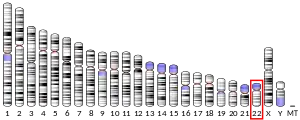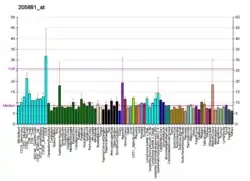| ZNF74 | |||||||||||||||||||||||||||||||||||||||||||||||||||
|---|---|---|---|---|---|---|---|---|---|---|---|---|---|---|---|---|---|---|---|---|---|---|---|---|---|---|---|---|---|---|---|---|---|---|---|---|---|---|---|---|---|---|---|---|---|---|---|---|---|---|---|
| Identifiers | |||||||||||||||||||||||||||||||||||||||||||||||||||
| Aliases | ZNF74, COS52, ZFP520, ZNF520, hZNF7, zinc finger protein 74 | ||||||||||||||||||||||||||||||||||||||||||||||||||
| External IDs | OMIM: 194548 HomoloGene: 88675 GeneCards: ZNF74 | ||||||||||||||||||||||||||||||||||||||||||||||||||
| |||||||||||||||||||||||||||||||||||||||||||||||||||
| |||||||||||||||||||||||||||||||||||||||||||||||||||
| |||||||||||||||||||||||||||||||||||||||||||||||||||
| |||||||||||||||||||||||||||||||||||||||||||||||||||
| Wikidata | |||||||||||||||||||||||||||||||||||||||||||||||||||
| |||||||||||||||||||||||||||||||||||||||||||||||||||
Zinc finger protein 74 is a protein that in humans is encoded by the ZNF74 gene.[3][4][5] Schizophrenia susceptibility has been associated with a mutation in this protein.[6]
Interactions
References
- 1 2 3 GRCh38: Ensembl release 89: ENSG00000185252 - Ensembl, May 2017
- ↑ "Human PubMed Reference:". National Center for Biotechnology Information, U.S. National Library of Medicine.
- ↑ Aubry M, Marineau C, Zhang FR, Zahed L, Figlewicz D, Delattre O, Thomas G, de Jong PJ, Julien JP, Rouleau GA (August 1992). "Cloning of six new genes with zinc finger motifs mapping to short and long arms of human acrocentric chromosome 22 (p and q11.2)". Genomics. 13 (3): 641–8. doi:10.1016/0888-7543(92)90135-F. PMID 1639391.
- ↑ Dunham I, Shimizu N, Roe BA, Chissoe S, Hunt AR, Collins JE, Bruskiewich R, Beare DM, Clamp M, Smink LJ, Ainscough R, Almeida JP, Babbage A, Bagguley C, Bailey J, Barlow K, Bates KN, Beasley O, Bird CP, Blakey S, Bridgeman AM, Buck D, Burgess J, Burrill WD, O'Brien KP (December 1999). "The DNA sequence of human chromosome 22". Nature. 402 (6761): 489–95. Bibcode:1999Natur.402..489D. doi:10.1038/990031. PMID 10591208.
- ↑ "Entrez Gene: ZNF74 zinc finger protein 74".
- ↑ Takase, K.; T. Ohtsuki; O. Migita; M. Toru; T. Inada; K. Yamakawa-Kobayashi; T. Arinami (1 December 2001). "Association of ZNF74 gene genotypes with age-at-onset of schizophrenia". Schizophrenia Research. 52 (3): 161–165. doi:10.1016/s0920-9964(00)00191-2. PMID 11705709. S2CID 42865851.
- ↑ Grondin B, Côté F, Bazinet M, Vincent M, Aubry M (October 1997). "Direct interaction of the KRAB/Cys2-His2 zinc finger protein ZNF74 with a hyperphosphorylated form of the RNA polymerase II largest subunit". J. Biol. Chem. 272 (44): 27877–85. doi:10.1074/jbc.272.44.27877. PMID 9346935.
Further reading
- Aubry M, Demczuk S, Desmaze C, Aikem M, Aurias A, Julien JP, Rouleau GA (1994). "Isolation of a zinc finger gene consistently deleted in DiGeorge syndrome". Hum. Mol. Genet. 2 (10): 1583–7. doi:10.1093/hmg/2.10.1583. PMID 8268910.
- Grondin B, Bazinet M, Aubry M (1996). "The KRAB zinc finger gene ZNF74 encodes an RNA-binding protein tightly associated with the nuclear matrix". J. Biol. Chem. 271 (26): 15458–67. doi:10.1074/jbc.271.26.15458. PMID 8663113.
- Grondin B, Côté F, Bazinet M, Vincent M, Aubry M (1997). "Direct interaction of the KRAB/Cys2-His2 zinc finger protein ZNF74 with a hyperphosphorylated form of the RNA polymerase II largest subunit". J. Biol. Chem. 272 (44): 27877–85. doi:10.1074/jbc.272.44.27877. PMID 9346935.
- Ravassard P, Côté F, Grondin B, Bazinet M, Mallet J, Aubry M (2000). "ZNF74, a gene deleted in DiGeorge syndrome, is expressed in human neural crest-derived tissues and foregut endoderm epithelia". Genomics. 62 (1): 82–5. doi:10.1006/geno.1999.5982. PMID 10585771.
- Côté F, Boisvert FM, Grondin B, Bazinet M, Goodyer CG, Bazett-Jones DP, Aubry M (2001). "Alternative promoter usage and splicing of ZNF74 multifinger gene produce protein isoforms with a different repressor activity and nuclear partitioning". DNA Cell Biol. 20 (3): 159–73. doi:10.1089/104454901300069004. PMID 11313019.
- Takase K, Ohtsuki T, Migita O, Toru M, Inada T, Yamakawa-Kobayashi K, Arinami T (2001). "Association of ZNF74 gene genotypes with age-at-onset of schizophrenia". Schizophrenia Research. 52 (3): 161–5. doi:10.1016/S0920-9964(00)00191-2. PMID 11705709. S2CID 42865851.
- Germain-Desprez D, Bazinet M, Bouvier M, Aubry M (2003). "Oligomerization of transcriptional intermediary factor 1 regulators and interaction with ZNF74 nuclear matrix protein revealed by bioluminescence resonance energy transfer in living cells". J. Biol. Chem. 278 (25): 22367–73. doi:10.1074/jbc.M302234200. PMID 12684500.
- Collins JE, Wright CL, Edwards CA, Davis MP, Grinham JA, Cole CG, Goward ME, Aguado B, Mallya M, Mokrab Y, Huckle EJ, Beare DM, Dunham I (2005). "A genome annotation-driven approach to cloning the human ORFeome". Genome Biol. 5 (10): R84. doi:10.1186/gb-2004-5-10-r84. PMC 545604. PMID 15461802.
- Kimura K, Wakamatsu A, Suzuki Y, Ota T, Nishikawa T, Yamashita R, Yamamoto J, Sekine M, Tsuritani K, Wakaguri H, Ishii S, Sugiyama T, Saito K, Isono Y, Irie R, Kushida N, Yoneyama T, Otsuka R, Kanda K, Yokoi T, Kondo H, Wagatsuma M, Murakawa K, Ishida S, Ishibashi T, Takahashi-Fujii A, Tanase T, Nagai K, Kikuchi H, Nakai K, Isogai T, Sugano S (2006). "Diversification of transcriptional modulation: Large-scale identification and characterization of putative alternative promoters of human genes". Genome Res. 16 (1): 55–65. doi:10.1101/gr.4039406. PMC 1356129. PMID 16344560.
External links
- ZNF74+protein,+human at the U.S. National Library of Medicine Medical Subject Headings (MeSH)
This article incorporates text from the United States National Library of Medicine, which is in the public domain.
This article is issued from Wikipedia. The text is licensed under Creative Commons - Attribution - Sharealike. Additional terms may apply for the media files.


